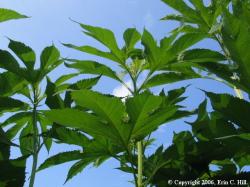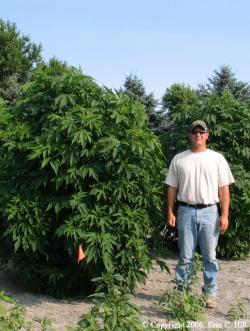Giant ragweed
Giant Ragweed (Ambrosia trifida L.)

Life cycle:
Summer annual. Emerges in the spring sets seed in late summer/fall and dies.
Emergence:
Giant ragweed is one of the first summer annials to emerge. Ten percent emergence has been seen by 150 GDD (base 48 F). Emergence patterns vary across areas of the north central region. Where giant ragweed is a problem, there are multiple flushes (emergence events ) throughout the growing season.
Giant ragweed can emerge from soil depths as deep as 6".

Seed:
Production Average: Giant ragweed plants can produce approximately 10,300 seeds per plant; growing with corn and soybean, giant ragweed produced 1.900 and 5,500 seeds per plant, respectively
Dispersal Mechanisms: None.
Longevity: The seed of giant ragweed is not very persistent. It takes 2 years to deplete the seedbank by 99%.
Dormancy: Giant ragweed seed requires an overwintering period to break dormancy.
Competitiveness:
Giant ragweed is probably the most competitive weed in agronomic crops in Michigan. One giant ragweed plant per 10ft^2 can reduce soybean yield by 52% and corn yield by 55%.
Preferred Soil / Field Conditions:
This weed prefers rich soils, fertile in N, P, K.

Management:
Biological
Predation: Larvae of a fruit fly, two weevil species, and a moth can reduce giant ragweed seed viability from 13 to 19% prior to seed shed. After dispersal, rodents (e.g. field mice), earthworms, and insects inclusding carabid beetles eat giant ragweed seed that is lying on the soil surface. In one study, 90% of giant ragweed seeds were removed by rodents and invertebrates in on year's time when left on the soil surface.
Decay: There is some evidence of giant ragweed seed decay in the first winter. Currently, decay rates and mechanisms are being studied. Soil moisture and soil microorganisms are needed to decay weeds seeds.
Mechanical
Tillage: Tillage controls emerged giant ragweed seedlings, but it also stimulates giant ragweed germination. This weed does not respond to night tillage.
Rotary hoeing: Giant ragweed is not easily controlled using a rotary hoe.
Flaming: Flaming is not an effective method of controlling giant ragweed.
Cultural
Crop rotation: Giant ragweed does not tolerate mowing (include a forage in the rotation); small grains in the rotation suppress giant ragweed.
Planting date: For giant ragweed populations that do not have extended emergence, tilling in the spring and planting later (mid-May) will reduce giant ragweed infestations because many plants will have emerged and been controlled by tillage.
Ensiling: Unlike many weed seeds, those of giant ragweed can survive ensiling.
Chemical
Application timing and effectiveness: Giant ragweed is one of the more difficult weeds to control with herbicides. Populations resistant to certain classes of herbicides are known. soil applied herbicides may not persist long enough to control all emergence events, and because giant ragweed can emerge from 6 inches deep, seedlings may emerge below the active herbicide layer. Control is also difficult with postemergence herbicides because of giant ragweed's tremendous growth rate. Herbicide application timing is critical for effective control; a sequential programs will probably be needed for control.



 Print
Print Email
Email